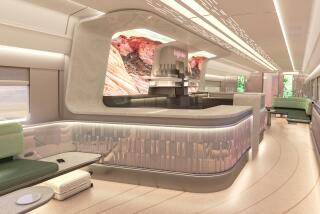Freight railroads pledge to install advanced safety measures by 2012
- Share via
Two freight railroads that share track with Metrolink commuter trains pledged Wednesday to install advanced safety measures in Southern California three years sooner than a new federal law would require -- with several caveats.
Burlington Northern Santa Fe and Union Pacific executives, who called U.S. Sen. Dianne Feinstein (D-Calif.) earlier this week to inform her of their decision, said the system’s complexity may prevent a complete rollout by 2012.
Feinstein announced the agreement in Van Nuys during a state Senate hearing on rail safety called after the Sept. 12 head-on collision of a Metrolink train and a Union Pacific freight train that killed 25 people and injured 135.
“If [the safety system known as] positive train control had been in place on Metrolink on Sept. 12, I believe 25 people would still be alive today,” Feinstein said.
Feinstein, who along with U.S. Sen. Barbara Boxer (D-Calif.), held her own hearing just days after the Chatsworth crash, said she intends to hold the freight lines to their promise to deploy the system in Southern California by 2012.
President Bush is expected to sign into law a bill that requires rail companies to install advanced safety systems nationwide by 2015.
Positive train-control systems combine digital communications with global positioning system technology to monitor train locations and speeds. If engineers fail to comply with signals sent from instruments along the tracks, an electronic device in the train’s cab automatically applies the brakes.
But freight company executives said they need help from federal regulators to ensure that they can install and operate the safety improvements.
Executives from the two companies told state lawmakers that they need more space on the crowded radio spectrum for the system to communicate with nearby trains, as well as additional funding to install it.
“We’re close to working all the bugs out,” said Thomas Jacobi, vice president of operations and technology for Union Pacific.
“But it’s not something we’re taking off the shelf. It’s apt to cause greater safety concerns by implementing it too quickly.”
The system also requires testing to ensure that those installed on freight trains will work with similar units on commuter rail lines.
Experts say such a fail-safe system would greatly improve train safety in Southern California, where so many miles of track are shared by both commuter lines and freight carriers heading to and from the busy Port of Los Angeles.
The freight companies also testified that the system is too difficult and expensive to install on all their locomotives by 2012, although their tracks should be equipped with the system by then.
Union Pacific will install the technology on 60 miles of track it operates between downtown L.A. and Riverside, while Burlington Northern’s system will span 66 miles between Santa Barbara and Los Angeles.
Union Pacific hopes to have 2,000 locomotives that operate in Southern California equipped with the system by 2012, although executives said they “couldn’t commit” to that date.
Burlington Northern said it couldn’t say how many of its 1,000 locomotives may be equipped by that time.
Feinstein said she expected the Federal Railroad Administration to step up and ensure that rail companies follow through on promises to deliver safety improvements.
“One of my findings has been that industry groups candidly get too cozy with the people they’re supposed to regulate,” she said. “That’s a problem and it’s got to stop.”
State senators during the hearing repeatedly questioned freight company executives and rail safety officials about why advanced safety systems have taken so long to roll out in the United States. Similar technology is in use in Europe.
“It’s so frustrating. These have been around so many years,” said state Sen. Alan Lowenthal (D-Long Beach). “We’re delivering goods throughout the nation and yet our residents are not safe.”
In a separate interview, Feinstein said she was pleased to see how Metrolink’s board had responded since the crash, ordering a second engineer into many commuter trains.
Federal investigators say the engineer involved in the Chatsworth crash did not heed a warning signal light and had been receiving and sending text messages on his cellphone seconds before the crash.
More to Read
Sign up for Essential California
The most important California stories and recommendations in your inbox every morning.
You may occasionally receive promotional content from the Los Angeles Times.










